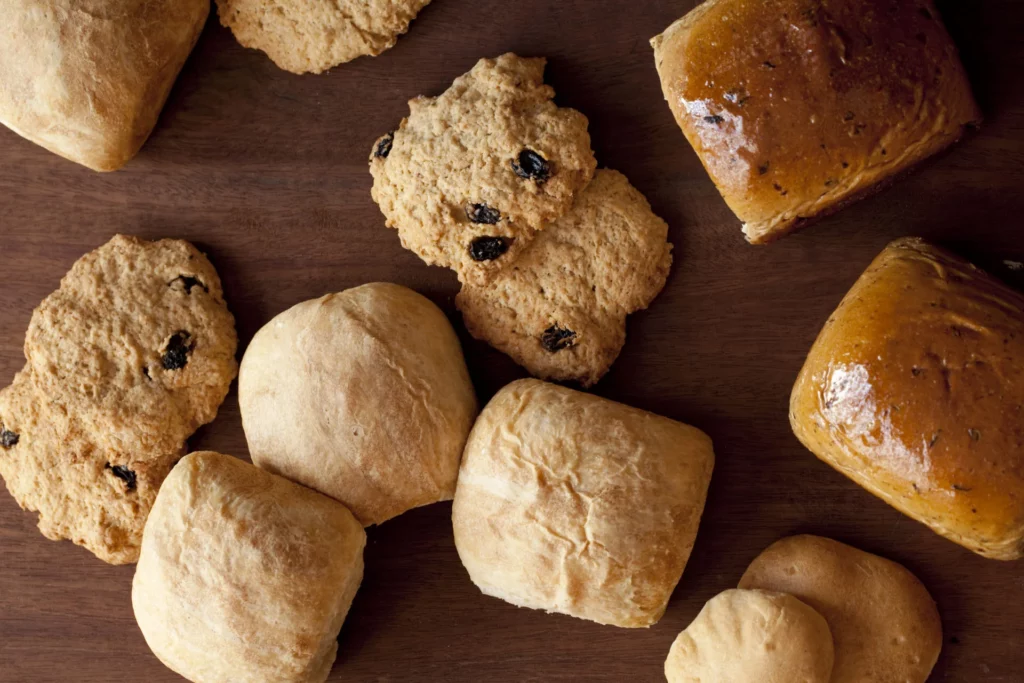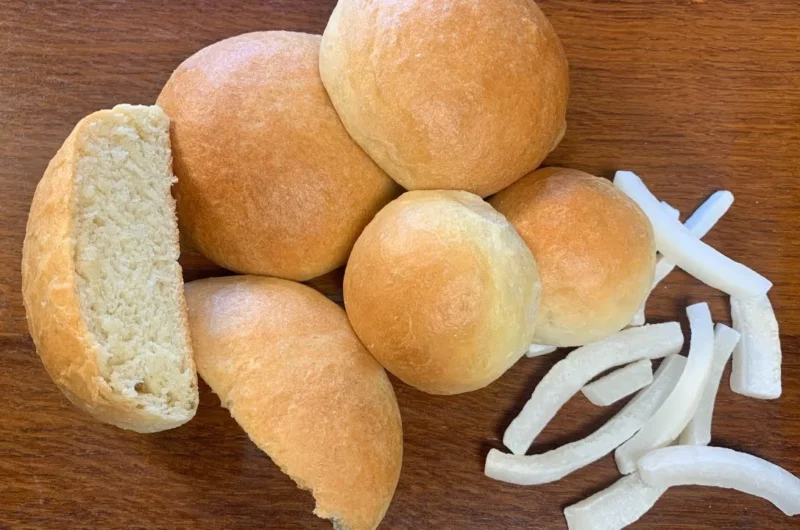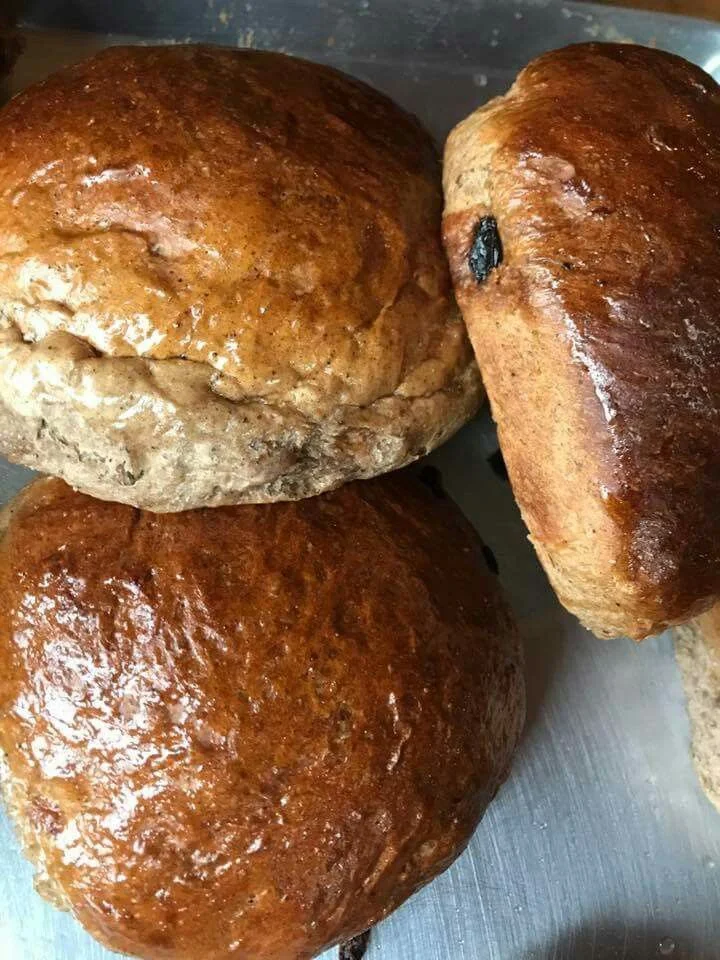Are you ready to embark on a journey to taste the freedom of Belizean Creole Bread? This tantalizing recipe is a symbolic representation of the vibrant culture and spirit of Belize. With its golden crust and fluffy interior, it beckons you to break free from the ordinary and savor a slice of paradise.
From mixing the dough to the final bake, this authentic recipe will transport your taste buds to the sunny shores of Belize. Get ready to experience a taste of liberation like never before.
Contents
- 1 Key Takeaways
- 2 Belizean Creole Bread Recipe
- 3 Ingredients
- 4 Mixing the Dough
- 5 Proofing the Bread
- 6 Shaping and Baking
- 7 Serving Suggestions
- 8 Tips and Variations
- 9 Nutritional Facts:-
- 10 Frequently Asked Questions
- 10.1 What Is the History Behind Belizean Creole Bread?
- 10.2 Can I Use All-Purpose Flour Instead of Bread Flour for This Recipe?
- 10.3 How Long Does It Take for the Dough to Rise During the Proofing Process?
- 10.4 Can I Freeze the Dough and Bake It Later?
- 10.5 Are There Any Traditional Toppings or Spreads That Are Commonly Served With Belizean Creole Bread?
- 11 Conclusion
Key Takeaways
- The dough for Belizean Creole Bread is made with high-quality flour, yeast, sugar, salt, and water.
- The dough is kneaded for about 10 minutes until smooth and elastic, and any dryness or stickiness can be adjusted by adding water or flour.
- The dough is then proofed, allowing it to double in size for 1-2 hours, which develops the flavor and texture of the bread.
- Finally, the well-risen dough is shaped into a loaf or rolls, baked at the recommended temperature until golden crust and fluffy interior are achieved.
Belizean Creole Bread Recipe
Course: Bread/BakingCuisine: Belizean/CaribbeanDifficulty: Medium4
30
minutes3
300
kcalDive into the heart of Belizean culinary tradition with our Belizean Creole Bread Recipe. This tropical delight blends the rich flavors of the Caribbean with a touch of Creole magic. Baking this bread is not just a culinary experience; it's a journey to the sun-soaked shores of Belize in every mouthful.
Ingredients
4 cups all-purpose flour
1/2 cup sugar
2 teaspoons active dry yeast
1 teaspoon salt
1 cup coconut milk (warmed)
1/4 cup unsalted butter (melted)
1 egg
Directions
- Begin by activating the yeast. In a bowl, combine warm coconut milk and sugar. Sprinkle yeast over the mixture and let it bloom for 5-7 minutes.
- In a large mixing bowl, combine flour and salt. Make a well in the center.
- Pour the yeast mixture into the well, add melted butter and beaten egg.
- Knead the dough until smooth and elastic. Allow it to rise in a warm place for 1-2 hours, or until doubled in size.
- Punch down the dough, shape it into a loaf, and place it in a greased baking pan.
Ingredients
To make Belizean Creole bread, you’ll need a few essential ingredients. First and foremost, you’ll need flour – the foundation of any good bread. Look for a high-quality, all-purpose flour that will give your bread a light and fluffy texture.
Next, you’ll need yeast, the magical ingredient that will make your dough rise and create those irresistible air pockets. Don’t forget about sugar, which will help activate the yeast and add a touch of sweetness to your bread. Salt is also crucial for enhancing the flavors and balancing the sweetness.
Lastly, you’ll need water – the liquid that brings everything together. Now that you have your ingredients, it’s time to move on to the exciting part: kneading techniques.
Mixing the Dough
Now it’s time to mix the dough, bringing together all the essential ingredients mentioned earlier. To ensure your Belizean Creole bread turns out light and fluffy, follow these proper kneading techniques:
- Start by placing the dough on a clean, floured surface.
- Use the heels of your hands to push the dough away from you, folding it back over itself.
- Rotate the dough a quarter turn and repeat the process, adding more flour if necessary to prevent sticking.
- Continue kneading for about 10 minutes until the dough becomes smooth and elastic.
Troubleshooting common dough mixing mistakes:
- If the dough feels too dry, add a little water, a teaspoon at a time, until it reaches the right consistency.
- If the dough feels too sticky, sprinkle in a little extra flour, a tablespoon at a time, until it becomes more manageable.
Proofing the Bread
Once you have finished kneading the dough, it’s time to allow the bread to proof. This is an essential step in the bread-making process as it allows the dough to rise and develop its delicious flavor and texture.
To begin, find a warm spot in your kitchen where the dough can rest undisturbed. Cover it with a clean kitchen towel or plastic wrap to create a cozy environment for the yeast to activate.
The yeast, a key ingredient, will consume the sugars in the dough and release carbon dioxide, causing the dough to rise. Be patient as the dough needs time to double in size, usually around one to two hours.
This crucial step ensures that your Belizean Creole Bread will be light, fluffy, and bursting with flavor.
Shaping and Baking
Now that your dough has finished proofing, it’s time to move on to the exciting part – shaping and baking your Belizean Creole bread!
First, make sure to preheat your oven to the recommended temperature and set a timer for the suggested baking time.
Next, take your well-risen dough and gently shape it into your desired loaf or rolls, being careful not to deflate it too much.
Baking Temperature and Time
To ensure a perfectly baked Belizean Creole bread, you should carefully monitor the baking temperature and time. By following these guidelines, you’ll be able to achieve a delicious loaf with a golden crust and a soft, fluffy interior.
Here are three important things to keep in mind when it comes to baking temperature and time:
- Preheat your oven: Before placing the bread dough in the oven, make sure to preheat it to the specified temperature. This ensures that the bread bakes evenly and rises properly.
- Check for doneness: To determine if your bread is fully baked, insert a toothpick or a skewer into the center. If it comes out clean, without any dough sticking to it, your bread is ready.
- Troubleshoot common baking issues: If you encounter problems like uneven browning or a doughy interior, adjust the baking temperature or time accordingly. It may take a few tries to find the perfect balance for your oven.
Proper Dough Shaping
After carefully monitoring the baking temperature and time, it’s now time to move on to shaping and baking the Belizean Creole bread dough.
Proper dough shaping is crucial to ensure a beautiful and delicious loaf. Different types of bread require different shaping techniques.
For a round loaf, gently flatten the dough into a rectangle and fold it in thirds, then shape it into a tight ball by tucking the edges underneath.
For a baguette, roll the dough into a long, thin rectangle and tightly roll it up.
Avoid common mistakes such as overworking the dough, as it can result in a dense and tough texture. Also, make sure to evenly distribute the yeast and avoid excessive flour on your work surface.
Achieving a Golden Crust
To achieve a golden crust on your Belizean Creole bread, it’s important to follow proper shaping and baking techniques. These techniques won’t only give your bread a beautiful color but also enhance its flavor and texture. Here are some tips to help you achieve that perfect golden crust:
- Shape the dough properly: Ensure that you shape the dough into a smooth, tight ball. This will help the bread retain its shape and create an even crust.
- Use the right flour: Different types of flour can give your bread different crust colors. If you want a darker crust, consider using whole wheat flour or adding a bit of malt powder to the dough.
- Bake at the right temperature: Preheat your oven to the recommended temperature and place a baking stone or sheet in the oven. This will help create a crisp and golden crust.
Once your Belizean Creole bread is baked to perfection, it’s important to know how to store it. To keep it fresh for longer, wrap the bread tightly in foil or store it in an airtight container.
Enjoy your delicious bread with the freedom to savor every bite!
Serving Suggestions
So, you’ve baked a delicious Belizean Creole Bread and now you’re wondering how to serve it? Well, let me give you some ideas.
First, you can get creative with toppings and spreads like butter, jam, or even avocado slices.
Secondly, this bread pairs perfectly with hearty soups, whether it’s a comforting bowl of chicken soup or a spicy seafood gumbo.
Lastly, don’t underestimate the power of this bread as a breakfast or snack option – it’s great toasted with a cup of coffee or as a base for tasty sandwiches.
The possibilities are endless!
Toppings and Spreads
Creating delicious combinations of toppings and spreads is key to enhancing the flavor of your Belizean Creole bread. Here are some mouthwatering suggestions to take your bread to the next level:
- Fresh Tropical Fruits: Slice up some juicy mangoes, pineapples, or papayas to add a burst of sweetness to your bread. The tropical flavors will transport you to the sunny beaches of Belize.
- Creamy Coconut Butter: Spread a generous amount of creamy coconut butter on your warm bread. The rich and smooth texture, combined with the hint of coconut flavor, will leave you wanting more.
- Homemade Guava Jam: Indulge in the tangy and sweet flavors of homemade guava jam. The vibrant pink color and tropical taste will bring a burst of joy to your taste buds.
Whether you choose to top your Belizean Creole bread with fresh fruits, creamy coconut butter, or homemade guava jam, each bite will be a delightful explosion of flavors.
Pairing With Soups
Enhance your dining experience by pairing your Belizean Creole bread with a variety of soups.
The unique flavors and textures of the bread make it a perfect companion to a warm bowl of soup. Whether you prefer a hearty tomato soup or a creamy seafood chowder, there are endless pairing options to explore.
The crusty exterior of the bread pairs well with rich and flavorful soups, while the soft and fluffy interior provides a comforting contrast. For a burst of freshness, try pairing the bread with a light vegetable soup or a tangy gazpacho.
The possibilities are endless, allowing you to create delicious flavor combinations that will satisfy your cravings and leave you feeling completely satisfied.
Breakfast or Snack?
Pair the Belizean Creole bread with a variety of soups for a comforting breakfast or snack. Is Creole bread a traditional Belizean breakfast? Absolutely! It’s a staple in Belizean households, often enjoyed in the morning alongside a cup of hot coffee or tea.
The warm, fluffy bread pairs perfectly with a bowl of hearty soup, such as chicken or seafood. Is Creole bread a popular snack in Belize? Without a doubt! Its versatility makes it an ideal choice for a quick and satisfying snack. Whether you enjoy it on its own, spread with butter or jam, or even turned into a sandwich with your favorite fillings, Creole bread is a delicious and convenient option for anytime snacking.
Tips and Variations
To add variety and customize your Belizean Creole bread, try experimenting with different ingredients and techniques. One way to switch things up is by using different bread flours. Instead of sticking to the traditional all-purpose flour, you could try using whole wheat flour for a heartier texture, or even incorporate rye or cornmeal for a unique flavor. Another option is to add nuts and seeds to the dough. This not only adds a delicious crunch, but also boosts the nutritional value of your bread. Consider adding chopped almonds, walnuts, or sunflower seeds for a delightful twist. You could even sprinkle some sesame or poppy seeds on top for added visual appeal. Don’t be afraid to get creative and make this Belizean Creole bread truly your own.
| Flour | Nuts | Seeds |
|---|---|---|
| Whole wheat | Almonds | Sesame |
| Rye | Walnuts | Poppy |
| Cornmeal | Sunflower seeds | – |
Nutritional Facts:-
- Calories: 200 kcal
- Protein: 5g
- Carbohydrates: 35g
- Fat: 6g
- Saturated Fat: 4g
- Cholesterol: 25mg
- Sodium: 180mg
- Fiber: 2g
- Sugar: 8g
Frequently Asked Questions
What Is the History Behind Belizean Creole Bread?
Imagine uncovering the secrets of Belizean Creole bread, its history and origins. Delve into the past, discovering how this delectable creation emerged, leaving a trail of flavors and traditions that speak of freedom and culture.
Can I Use All-Purpose Flour Instead of Bread Flour for This Recipe?
Yes, you can use all-purpose flour instead of bread flour for the Belizean Creole bread recipe. It may result in a slightly denser texture, but it will still be delicious and satisfying. Enjoy the freedom to experiment with alternative flours!
How Long Does It Take for the Dough to Rise During the Proofing Process?
During the proofing process, the dough usually takes around 1-2 hours to rise. To ensure a successful proofing, find a warm place, cover the dough with a damp cloth, and be patient. The end result will be worth it!
Can I Freeze the Dough and Bake It Later?
Sure, you can definitely freeze the dough and bake it later! It’s a great way to have freshly baked bread whenever you want. Just make sure to let the dough thaw and rise before baking. Enjoy!
Are There Any Traditional Toppings or Spreads That Are Commonly Served With Belizean Creole Bread?
Common toppings and spreads that pair well with Belizean Creole bread include butter, jam, and cheese. These variations of creole bread provide the perfect canvas for your favorite flavors to shine. Enjoy the freedom to create your own delicious combinations!
Conclusion
In conclusion, the Belizean Creole bread recipe is a delightful combination of flavors and textures that will transport you to the beautiful country of Belize.
Its crusty exterior and soft, fluffy interior make it the perfect accompaniment to any meal.
So why not give this recipe a try and bring a taste of Belize into your own kitchen?
Remember, the secret ingredient is love, so be sure to savor every bite!





